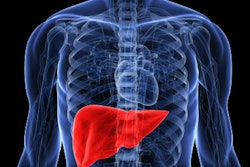
A deep-learning approach using a convolutional neural network (CNN) can accurately classify liver masses into five categories based on dynamic contrast-enhanced CT images, according to research from Japan published online recently in Radiology.
In a preliminary study, researchers led by Dr. Koichiro Yasaka, PhD, from the University of Tokyo Hospital found that their CNN model could classify liver masses at an overall accuracy rate of 84%. Although there is still room for improvement in detecting some rare types of malignant tumors, the algorithm shows promise for helping radiologists to characterize most of the liver masses they encounter on a regular basis in clinical practice, according to the group.
"Our current model may have potential to aid radiologists with less imaging experience in the differentiation of liver masses," Yasaka said.
Deep learning
 Dr. Koichiro Yasaka, PhD, from University of Tokyo Hospital.
Dr. Koichiro Yasaka, PhD, from University of Tokyo Hospital.
"We thought that this method might be easy to apply in daily clinical practice, and that it might have potential to differentiate liver masses with high diagnostic performance," he told AuntMinnie.com.
The researchers trained the CNN using sets of dynamic contrast-enhanced CT images that were obtained at their institution between January 2013 and December 2013 to evaluate liver lesions. The radiologic reports for these studies, as well as specific pathologic and imaging criteria, were used to categorize the liver masses or mass-like lesions into five categories:
- Category A: classic hepatocellular carcinomas (HCCs)
- Category B: malignant liver tumors other than classic and early HCCs (e.g., intrahepatic cholangiocellular carcinomas, combined hepatocellular-cholangiocarcinomas, and liver metastases)
- Category C: indeterminate masses or mass-like lesions (e.g., early HCCs and dysplastic nodules) and rare benign liver masses other than hemangiomas and cysts
- Category D: liver hemangiomas
- Category E: cysts
Unsupervised learning was conducted with a CNN by using unenhanced, arterial, and delayed-phase images, as well as various combinations of these images. A total of 1,068 image sets from 460 patients were included in the training phase of the study (Radiology, October 23, 2017).
Image sets with up to five different table positions were included per lesion, and up to seven lesions per patient were assessed. Enlarged images were captured using Centricity Radiology RA 1000 software (GE Healthcare) and converted to 8-bit JPEG format. These images then received further image processing and data augmentation, which resulted in 52 image sets generated from each original dataset. A total of 55,536 image sets were then available for training the CNN, which consisted of six convolutional layers, three maximum pooling layers, and three fully connected layers, according to the team.
"Our deep-learning model requires the radiologists only to focus on the tumors, capture the images, and provide the image to the CNN," Yasaka said. "This method does not require complex-shaped regions of interest, tracing boundaries of tumors, or circular or elliptical regions of interest within tumors."
Five different deep-learning models were obtained based on the combination of images used for training. After the algorithms were trained, the researchers tested each of the models on CT image sets that had been obtained in 2016 from 100 patients. The best-performing model had been trained using all three image types: unenhanced, arterial, and delayed-phase CT images.
Highly sensitive
This algorithm was highly sensitive for the differential diagnosis of liver masses into the five categories:
- Category A: classic HCCs -- 15/21 (71%)
- Category B: malignant liver tumors other than classic and early HCCs -- 3/9 (33%)
- Category C: indeterminate masses or mass-like lesions and rare benign liver masses other than hemangiomas and cysts -- 33/35 (94%)
- Category D: liver hemangiomas -- 18/20 (90%)
- Category E: cysts -- 15/15 (100%)
The model yielded an overall accuracy of 84%. Delving deeper into the data, the researchers found that the models differentiated categories A-B from C-E at an area under the receiver operating characteristic (ROC) curve of 0.92.
"The CNN model could be useful for diagnosing most liver masses that we encounter in daily clinical practice; however, further improvement would be necessary to achieve adequate performance for diagnosis of relatively rare malignant liver masses," the authors wrote.
The group now plans to improve the model by collecting images of these relatively rare malignant liver masses, Yasaka said.





















